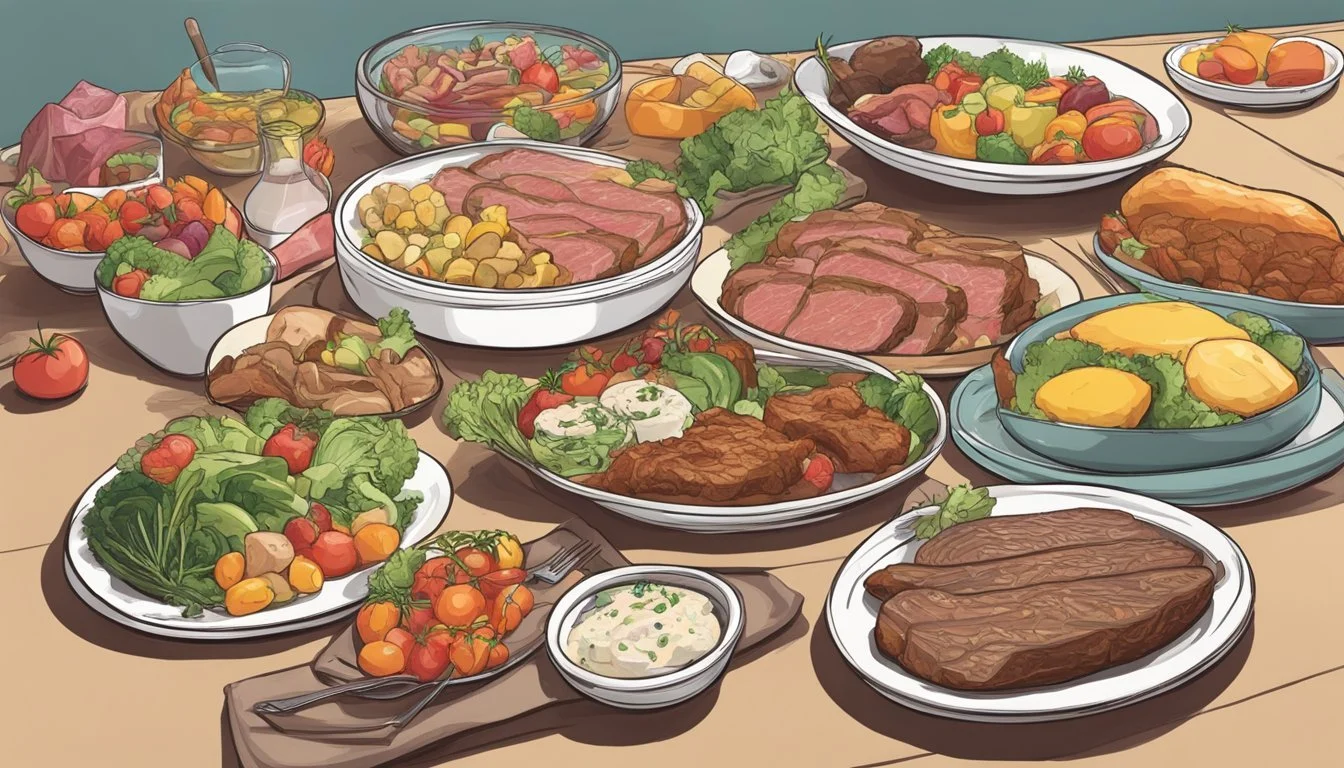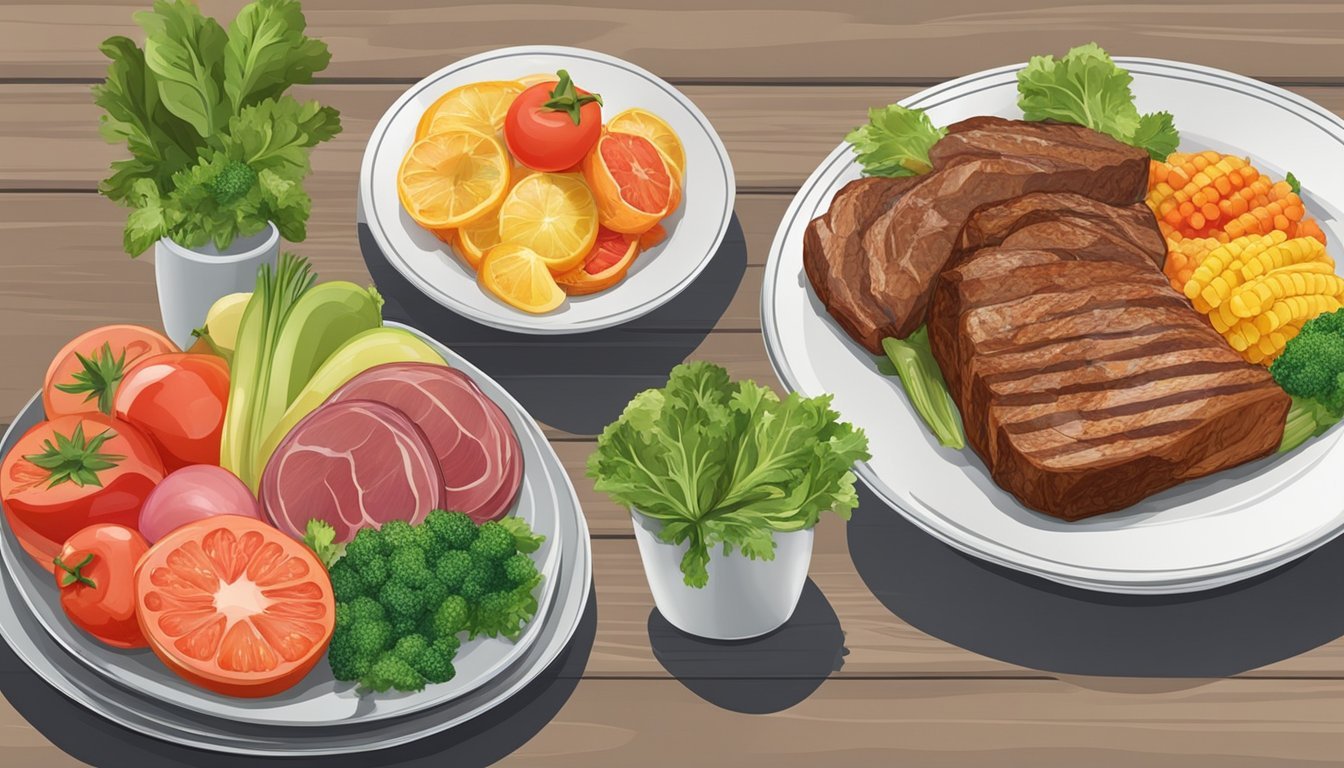Carnivore Diet vs. The Volumetrics Diet
Fullness and Satisfaction Compared
The Carnivore Diet and the Volumetrics Diet represent two vastly different approaches to eating, weight management, and nutritional focus. The Carnivore Diet is a high-protein, low-carbohydrate diet that exclusively includes animal products such as meat, fish, and dairy, with proponents arguing that it leads to weight loss and improved health markers. In contrast, the Volumetrics Diet is based on the energy density of foods; it encourages consumption of low-calorie, high-volume foods like fruits and vegetables to promote satiety and facilitate weight loss without the need for strict calorie counting.
When considering fullness and satisfaction, both diets aim to mitigate hunger and increase satisfaction following meals, albeit via different mechanisms. The Carnivore Diet relies on the satiating properties of protein, while the Volumetrics Diet focuses on consuming larger volumes of food with fewer calories, which may help avoid the feeling of deprivation that can accompany some weight loss regimes. Each diet offers a unique blueprint for addressing one's relationship with food and hunger, and each comes with its set of pros and cons.
It is crucial to evaluate these diets based on individual health goals, dietary preferences, and any specific medical advice one has received. Understanding both the scientific underpinnings and personal testimonies related to each can provide insight into how each diet might influence feelings of fullness and overall satisfaction.
Overview of Carnivore and Volumetrics Diets
The Carnivore and Volumetrics diets represent contrasting nutritional philosophies. The former focuses on high-protein, animal-based foods, while the latter emphasizes low-calorie, high-volume eating through plant-based choices.
Definition of Carnivore Diet
The Carnivore Diet is a regimen that consists exclusively of animal products. Proponents consume a variety of meats, including beef, chicken, and fish, alongside eggs and select dairy products. This diet trend eliminates all plant-based foods, arguing for benefits such as increased satiety and potential health improvements. A typical meal plan is high in fat and protein, with zero carbohydrates from vegetable or fruit sources.
Definition of Volumetrics Diet
The Volumetrics Diet, in contrast, is built around the concept of energy density. This diet encourages the consumption of foods that are low in calories but high in volume, such as fruits, vegetables, whole grains, and lean proteins. It aims to promote fullness and reduce overall caloric intake without restrictive portion control. Foods are categorized based on their calorie content relative to their weight, guiding followers to make satiating yet low-calorie choices.
Dietary Focus and Principles
The Carnivore Diet and the Volumetrics Diet represent two distinct approaches to eating, with one focusing on consumption of animal products exclusively and the other emphasizing a high intake of low-calorie density plant foods to promote satiety and weight management.
Focus on Animal Products
The Carnivore Diet places its emphasis strictly on animal products, with meat being the centerpiece of its philosophy. This diet is built on the premise that consuming a diet rich in proteins and fats, derived primarily from animal sources, aligns with human evolutionary dietary patterns. Individuals following this diet will consume:
Meat: Beef, chicken, pork, lamb, organ meats
Fish and Seafood: Salmon, trout, mackerel
Eggs: Chicken, duck, and other varieties
Dairy: Hard cheeses, butter, and heavy cream (though some variants minimize dairy)
The diet argues that plant foods are not necessary and that a meat-based diet can provide all the essential nutrients needed. However, it largely excludes important sources of fiber, vitamins, and minerals found in fruits, vegetables, and whole grains.
Focus on Low-Calorie Density
The Volumetrics Diet, in contrast, is based on the idea of consuming foods with low energy density to achieve a feeling of fullness with fewer calories. It emphasizes eating more water-rich and fiber-rich plant foods which allow for larger portions that are less calorie-dense. It includes a variety of food groups:
Fruits and Vegetables: Apples, berries, leafy greens, carrots
Whole Grains: Brown rice, oatmeal, whole-wheat pasta
Lean Protein Sources: Turkey, chicken, beans, tofu
Low-fat Dairy: Skim milk, Greek yogurt
These food categories are rich in water, fiber, and nutrients, and low in calories, making them central to the Volumetrics approach. The diet's philosophy is that one can eat satisfying portions while still managing calorie intake.
Health Implications
When comparing the Carnivore Diet and the Volumetrics Diet, it is crucial to consider the health implications, which include the potential for weight loss, the risks of nutrient intake and deficiencies, and the impact on chronic diseases.
Weight Loss Potential
The Volumetrics Diet is structured around the concept of energy density, encouraging the consumption of low-calorie, high-volume foods like fruits and vegetables, which could lead to a feeling of fullness and reduce overall calorie intake. This approach potentially aids in gradual, sustainable weight loss by emphasizing satiety and adherence to a nutrient-rich diet.
In contrast, the Carnivore Diet, with its focus on high-protein, animal-based foods, may initially contribute to weight loss due to reduced appetite and lower insulin levels. However, it does not emphasize portion control or calorie counting, which might impact its long-term weight loss effectiveness.
Nutrient Intake and Deficiencies
The nutrient profile of the Volumetrics Diet typically includes a balance of protein, fiber, grains, nuts, seeds, and a wealth of necessary micronutrients from fruits and vegetables. Its comprehensive approach can help minimize the risk of nutrient deficiencies.
On the other hand, the Carnivore Diet prioritizes protein and fat, predominantly from animal sources, potentially lacking dietary fiber and essential nutrients commonly found in fruits, vegetables, grains, and dairy. Hence, people following this diet might be at risk for deficiencies in nutrients like vitamin C, calcium, and fiber.
Impact on Chronic Diseases
With respect to chronic diseases, diets rich in a variety of fruits, vegetables, and whole grains, such as the Volumetrics Diet, can reduce the risk of conditions like obesity, diabetes, heart disease, and certain cancers due to their low-saturated fat content and beneficial plant compounds.
Conversely, the Carnivore Diet is high in saturated fats and might lead to increased LDL cholesterol levels, posing a heightened risk for heart disease. Its exclusion of plant-based foods also removes a source of numerous phytochemicals and antioxidants that protect against various diseases. The long-term impact of such nutritional exclusions raises concerns among health professionals, especially regarding chronic disease prevention and management.
Satiety and Managing Hunger
Managing hunger effectively hinges on understanding how different diets influence satiety— the feeling of fullness after eating—and satisfaction, which relates to the pleasure derived from a meal. The Carnivore Diet focuses on animal-based foods high in protein and fats, while the Volumetrics diet emphasizes low-density, nutrient-rich foods like vegetables that are high in water and fiber.
Fullness on the Carnivore Diet
The Carnivore Diet, being rich in proteins and fats, can potentially lead to a high level of fullness. Protein is known for its satiating effect, which helps reduce feelings of hunger and could lead to a lower energy intake overall. Fats, although energy-dense, also contribute to satiety; they take longer to digest, thus prolonging feelings of fullness.
Satisfaction on the Volumetrics Diet
Conversely, the Volumetrics Diet prioritizes foods with high water and fiber content—like vegetables—which provide volume without a high calorie count. This approach may offer lasting satiety and greater satisfaction due to the larger portion sizes allowed. Eating nutrient-dense foods that are low in calories but high in bulk can help individuals feel full while managing energy intake, aiding in weight maintenance or loss.
Meal Planning Strategies
When adopting a diet, effective meal planning strategies can support an individual's goals for fullness and satisfaction. These strategies vary distinctly between the Carnivore and Volumetrics diets due to their differing principles and recommended food groups.
Carnivore Diet Meal Planning
The Carnivore Diet meal plan is straightforward due to its focus on animal products. For a successful plan, one should prioritize a variety of proteins such as beef, chicken, fish, and pork for nutritional balance and to prevent meal fatigue. Eggs and high-fat dairy can be included for added nutrients.
Daily Meal Plan Example:
Breakfast: Scrambled eggs with bacon
Lunch: Grilled chicken breasts with melted cheddar cheese
Dinner: Ribeye steak (What wine goes well with ribeye steak?) or organ meat
Regular consumption of fatty meats and fish such as salmon is encouraged to satiate hunger and provide essential fats that may benefit overall health. Experimenting with recipes is limited to the preparation methods such as grilling, roasting, and slow cooking.
Volumetrics Diet Meal Planning
The Volumetrics Diet aims for a high volume of low-calorie foods. Meal plans center around fruits, vegetables, beans, legumes, and lean proteins. These foods are integrated into recipes to create filling meals that have low energy density.
Daily Meal Plan Example:
Breakfast: Egg white omelet with spinach, and a fruit and yogurt smoothie
Lunch: Brown rice bowl with shredded chicken, black beans, and salsa
Dinner: Halibut fillet with roast potatoes and steamed asparagus
One should focus on consuming soups and salads which can be both nutrient-rich and filling. Including a diverse range of vegetables and fruits can prevent boredom and maintain enthusiasm for the diet. Strategic use of low-fat dairy and whole grains enhances the diet plan without significantly increasing calorie density.
Potential Risks and Drawbacks
When examining the Carnivore and Volumetrics diets, one must consider the potential health risks and drawbacks associated with each. Both diets offer pathways to fullness and satisfaction, but they come with distinct considerations regarding nutrition and long-term health effects.
Risks of the Carnivore Diet
The Carnivore Diet involves consuming mostly, if not entirely, animal products including red meat, organ meat, and processed meats. This approach poses several risks:
Nutrient Deficiencies: A strict carnivore diet could result in deficiencies in vitamins C and E, fiber, and phytonutrients, which are typically derived from plant-based foods.
Increased Health Risks: High consumption of red and processed meats is associated with an increased risk of heart disease, colorectal cancer, and other health conditions due to elevated levels of saturated fats and sodium.
Processed Foods: Relying heavily on processed meats can introduce excessive amounts of sodium and preservatives into the diet, which is not considered safe in large amounts.
Considerations for the Volumetrics Diet
The Volumetrics Diet emphasizes low-calorie, high-volume foods such as fruits, vegetables, whole grains, and lean proteins to promote satiety and weight loss. Its considerations include:
Alcohol and Sodium: While not a focus, individuals should be mindful of their alcohol and sodium intake as they can contribute to health issues and may affect weight management despite a volumetric-focused eating pattern.
Drawbacks: Without careful planning, this diet might not provide adequate satiety for some, leading to potential overconsumption of foods, even if they are low in calories. Additionally, individuals who prefer denser foods may struggle with the lower calorie density prescribed by this diet.
In any diet, moderation and balance are key to minimizing risks and ensuring the intake of necessary nutrients for optimal health.
Sustainability and Environmental Impact
The carnivore diet and the Volumetrics diet hold vastly different implications for sustainability and environmental impact. One relies heavily on animal products, while the other emphasizes high-volume, low-calorie foods like vegetables, fruits, and whole grains.
Environmental Considerations of Meat Consumption
The production of meat, specifically beef and mutton, is resource-intensive and contributes significantly to greenhouse gas (GHG) emissions. For instance, beef production can emit up to 250 times more GHG than producing equivalent amounts of legumes. Dairy products also carry a substantial environmental footprint, although not as high as red meats. On the other hand, poultry, fish, and seafood represent somewhat more sustainable choices, with lower GHG emissions than red meat.
Furthermore, meat consumption impacts land and water use as well as biodiversity. Raising animals for food requires large tracts of land, contributing to deforestation and habitat loss. It also involves considerable water consumption and can lead to water pollution.
Volumetrics Diet and Sustainable Eating
The Volumetrics diet encourages the consumption of fruits, vegetables, grains, as well as moderate amounts of nuts and seeds. These food groups generally have a lower environmental impact compared to animal-based products. For example:
Vegetables and fruits require less land and water and, when sourced locally and seasonally, contribute to reduced transportation emissions.
Whole grains have a smaller carbon footprint per calorie when compared to meat and dairy.
Nuts and seeds, while higher in calories, can be produced with a lower GHG output than equivalent caloric amounts of meat.
Eating patterns that focus on plants rather than animals are typically more sustainable and decrease the environmental burden. The Volumetrics diet's emphasis on naturally lower-calorie density foods not only supports weight management but also aligns with sustainable eating practices.
Adaptive Practices for Dietary Success
The success of a diet often hinges on its adaptability to an individual's lifestyle and goals, balancing satiety with health benefits.
Adapting the Carnivore Diet for Longevity
Physical Activity and Exercise: Individuals following the Carnivore Diet should consider engaging in regular physical activity to support long-term weight loss and muscle maintenance. As the diet is high in fat and low in carbohydrates, one may need to adjust the intensity and type of exercise to match energy levels.
Healthy Lifestyle: Incorporating habits such as adequate sleep and stress management techniques can complement the diet's effects on health.
Nutrient Balance: Those practicing the Carnivore Diet can focus on adding variety within the constraints of the diet to ensure they are not only consuming muscle meats but also organ meats, which are rich in different nutrients. Additionally, ensuring the intake of healthy fats and omega-3s can be vital for cardiovascular health.
Incorporating Volumetrics Principles Sustainably
Low-Calorie Density Foods: To integrate Volumetrics principles, dieters are encouraged to consume foods with high water content, such as soups and salads, which provide a feeling of fullness with fewer calories.
Balanced Meals: By including a mix of protein, fiber, and healthy fats, individuals can create balanced meals that help maintain satiety while keeping calorie intake in check.
Portion Control: Utilizing volumetric principles for portion control can help those aiming for weight loss without feeling deprived. It allows for larger portion sizes of lower-calorie foods while still encouraging a reduction in overall energy intake.
By applying these adaptive practices, individuals following either the Carnivore or Volumetrics Diet can tailor their eating habits to their personal health goals and needs, promoting sustainability and success in their dietary endeavors.
Expert Opinions and Research
The Carnivore Diet and the Volumetrics Diet represent two vastly different approaches to nutrition and satiety. They have each been subjected to various degrees of scientific scrutiny, revealing a range of health implications and potential benefits.
Scientific Studies on Carnivore Diet
The Carnivore Diet strictly consists of animal products and excludes all other food groups. Research on this diet is less comprehensive than other diet trends, with studies primarily focusing on short-term outcomes. Its potential benefits for weight loss and certain inflammatory conditions have been discussed, but there remains a lack of long-term studies to assess the implications on heart disease, diabetes, and cancer, including colon cancer. Moreover, health experts caution about the risk of nutrient deficiencies and increased cholesterol levels due to the exclusion of plant-based foods.
Research Behind the Volumetrics Approach
The Volumetrics Diet, created by Barbara Rolls, a researcher at Penn State University, grounds its principles in the energy density of foods. It categorizes foods into four groups, where fruits and vegetables with high water content are considered to provide a sense of fullness with fewer calories. Substantial research supports this approach, highlighting its benefits for long-term weight management and potential to lower the risk of obesity.
Peer-reviewed studies have demonstrated the health benefits of a nutrient-dense, low-calorie diet that the Volumetrics espouses.
Barbara Rolls' research indicates a positive impact on heart health, attributing to the diet's balance of nutrients and emphasis on whole foods.
Both diets underline the importance of satiety; however, the Volumetrics Diet is backed by a firmer scientific foundation, with evidence suggesting its sustainable approach could aid in preventing chronic conditions like heart disease and obesity.
Tips for Individuals Considering Either Diet
Choosing between the Carnivore Diet and the Volumetrics Diet involves understanding their different approaches to fullness and satisfaction. Here are specific actions to take before committing to either diet plan.
Consulting Healthcare Providers
An individual considering a dietary change should always consult with a healthcare provider or a registered dietitian. This is crucial for assessing personal health needs and avoiding nutrient deficiencies. For the Carnivore Diet, which eliminates plant-based foods, essential nutrients typically obtained from fruits and vegetables, like vitamin C and fiber, might be lacking. Conversely, the Volumetrics Diet includes a variety of nutrient-dense foods across all food groups, aligning closely with the principles of healthy eating.
Here is a checklist for a discussion with a healthcare provider:
Personal health assessment: Evaluate if pre-existing conditions could be affected by diet changes.
Nutrient analysis: Identify potential nutrient deficiencies and discuss how to manage them.
Dietary preference compatibility: Ensure the diet aligns with one's preferences, such as keto, low-fat dairy, or vegetarian options for the Volumetrics Diet.
Adaptation guidance: Seek professional advice on how to adapt to the chosen diet with focus on lean proteins and essential nutrients.
Making Informed Nutritional Choices
Educating oneself on the nutritional aspect is a pivotal step. The Carnivore Diet's emphasis on animal products requires knowledge of how to source high-quality, nutrient-rich meats and manage the risk of high saturated fat intake. For the Volumetrics Diet, one should learn how to select low-density, high-volume foods that aid satiety without excessive calorie intake.
Key nutritional points for each diet:
Carnivore Diet: Research leaner cuts of meat that provide ample protein while controlling fat intake.
Volumetrics Diet: Focus on incorporating a balance of fruits, vegetables, whole grains, and low-fat dairy, ensuring each meal is filling and nutritionally complete.
Both diets present unique challenges and benefits to fullness and satisfaction. It is crucial for individuals to be well-informed and to work with nutritional professionals to ensure a balanced, sustainable approach to eating that meets their dietary needs and preferences.
Conclusion
The Carnivore Diet and the Volumetrics Diet represent two vastly different approaches to nutrition and weight management. Proponents of the Carnivore Diet argue that it simplifies eating and can lead to quick weight loss, while the Volumetrics Diet emphasizes a variety of foods that help achieve fullness and satisfaction.
Individuals adhering to the Carnivore Diet focus primarily on animal products, which can lead to a high intake of protein and fat. This diet may provide a sense of fullness, but the exclusion of plant-based foods could result in long-term nutritional deficiencies and is generally not considered sustainable by nutrition experts.
On the other hand, the Volumetrics Diet encourages consumption of foods with lower energy density, such as:
Fruits and vegetables
Broth-based soups
Whole grains
These food categories have been consistently linked with prolonged satiety. With an emphasis on a healthy lifestyle, this diet integrates calorie counting and physical activity, aiming for a more holistic and sustainable approach to weight loss.
Here's a comparison of the Carnivore Diet and the Volumetrics Diet across various aspects:
Primary Focus
Carnivore Diet: Animal products
Volumetrics Diet: Low-energy-density foods
Nutrient Diversity
Carnivore Diet: Limited (mostly protein and fat)
Volumetrics Diet: High (includes various macronutrients and micronutrients)
Sustainability
Carnivore Diet: Questionable (nutrient deficiencies)
Volumetrics Diet: More sustainable (encourages lifelong healthy eating habits)
Long-term Health Implications
Carnivore Diet: Potential for negative outcomes
Volumetrics Diet: Generally positive (if supplemented with regular exercise)
Calorie Counting
Carnivore Diet: Not typically emphasized
Volumetrics Diet: Encouraged
Physical Activity
Carnivore Diet: Not a primary component
Volumetrics Diet: Integral
In conclusion, for individuals seeking a diet that fosters both fullness and nutritional satisfaction, the evidence leans towards the Volumetrics Diet. This approach not only caters to the body's needs for various nutrients but also supports a sustainable and health-promoting lifestyle.










